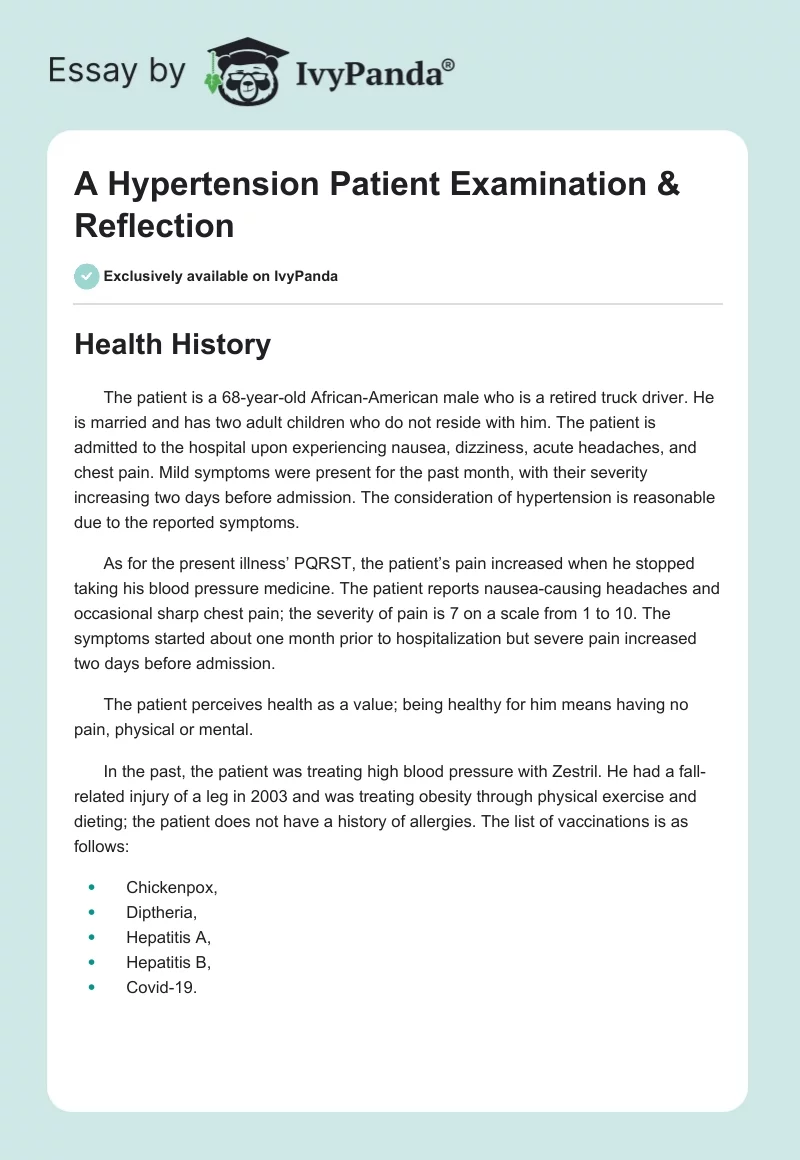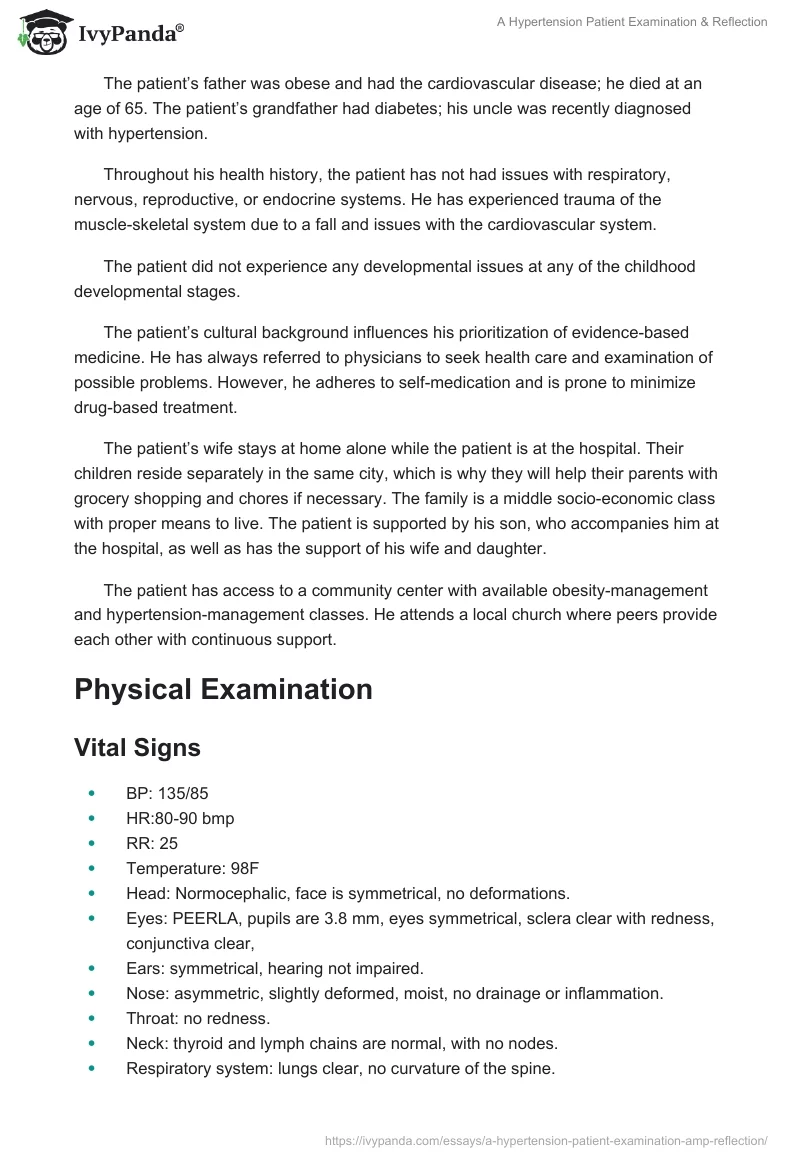Health History
The patient is a 68-year-old African-American male who is a retired truck driver. He is married and has two adult children who do not reside with him. The patient is admitted to the hospital upon experiencing nausea, dizziness, acute headaches, and chest pain. Mild symptoms were present for the past month, with their severity increasing two days before admission. The consideration of hypertension is reasonable due to the reported symptoms.
As for the present illness’ PQRST, the patient’s pain increased when he stopped taking his blood pressure medicine. The patient reports nausea-causing headaches and occasional sharp chest pain; the severity of pain is 7 on a scale from 1 to 10. The symptoms started about one month prior to hospitalization but severe pain increased two days before admission.
The patient perceives health as a value; being healthy for him means having no pain, physical or mental.
In the past, the patient was treating high blood pressure with Zestril. He had a fall-related injury of a leg in 2003 and was treating obesity through physical exercise and dieting; the patient does not have a history of allergies. The list of vaccinations is as follows:
- Chickenpox,
- Diptheria,
- Hepatitis A,
- Hepatitis B,
- Covid-19.
The patient’s father was obese and had the cardiovascular disease; he died at an age of 65. The patient’s grandfather had diabetes; his uncle was recently diagnosed with hypertension.
Throughout his health history, the patient has not had issues with respiratory, nervous, reproductive, or endocrine systems. He has experienced trauma of the muscle-skeletal system due to a fall and issues with the cardiovascular system.
The patient did not experience any developmental issues at any of the childhood developmental stages.
The patient’s cultural background influences his prioritization of evidence-based medicine. He has always referred to physicians to seek health care and examination of possible problems. However, he adheres to self-medication and is prone to minimize drug-based treatment.
The patient’s wife stays at home alone while the patient is at the hospital. Their children reside separately in the same city, which is why they will help their parents with grocery shopping and chores if necessary. The family is a middle socio-economic class with proper means to live. The patient is supported by his son, who accompanies him at the hospital, as well as has the support of his wife and daughter.
The patient has access to a community center with available obesity-management and hypertension-management classes. He attends a local church where peers provide each other with continuous support.
Physical Examination
Vital Signs
- BP: 135/85
- HR:80-90 bmp
- RR: 25
- Temperature: 98F
- Head: Normocephalic, face is symmetrical, no deformations.
- Eyes: PEERLA, pupils are 3.8 mm, eyes symmetrical, sclera clear with redness, conjunctiva clear,
- Ears: symmetrical, hearing not impaired.
- Nose: asymmetric, slightly deformed, moist, no drainage or inflammation.
- Throat: no redness.
- Neck: thyroid and lymph chains are normal, with no nodes.
- Respiratory system: lungs clear, no curvature of the spine.
- Cardiovascular system: elevated HR, hypertensive BP, heartbeat sound clear.
- Neurological system: Patient is alert and responsive, mildly anxious, and speech is clear. Reflexes normal, facial muscles normal, normal sensation.
- Gastrointestinal system: abdomen is symmetric, tender on palpation, urination frequency normal, and bowel sounds normal.
- Musculoskeletal system: Upper extremities symmetrical, normal joints, lower extremities asymmetrical, left leg has minor bone deformation, muscle strength normal.
- Peripheral vascular system: reported chest pain, hypertensive BP.
Needs Assessment
Given the patient’s history of experiencing pain associated with hypertension and his neglect of high blood pressure medication intake, it is reasonable to provide him with the necessary learning materials to ensure his awareness about the disease. Dieting and physical exercise are two most important lifestyle adjustments that might minimize the risks of hypertensive crisis. The patient is advised to adhere to healthy dieting and regular exercising to stabilize blood pressure and eliminate risks of comorbidities.
Firstly, it is recommended to learn more about foods to avoid and diet to follow in hypertension. The patient is advised to examine the information in the article by Schwingshackl et al. (2019) to fill this gap in knowledge. Secondly, the patient is recommended to follow a regular physical exercise routine with special attention paid to activities aimed at reducing high blood pressure. The information on these issues will be accessible from the article by Rêgo et al. (2019). Thus, the patient’s learning needs will be supported by cultural appraisal of healthy lifestyles. Using family and community support accompanied by the patient’s mental strength in addressing the issue, he is anticipated to succeed.
Reflection
The interaction with the interviewee was set in a hospital room in the morning in a friendly and trusting manner. The communication was more intuitive in relation to what I had learned since I had to adjust my questions as I learned more about the patient. The patient’s anxiety was a barrier to communication; I was able to establish a supporting relationship to minimize his anxiety; in the future, I will follow the same approach to help the patient calm down. The assessment went as planned, with all information obtained accurately. There were no unanticipated challenges during this assignment; I wish I had more experience in communicating interculturally. In the future, I will ensure to use a person-centered approach in a better way.
References
Rêgo, M. L., Cabral, D. A., Costa, E. C., & Fontes, E. B. (2019). Physical exercise for individuals with hypertension: It is time to emphasize its benefits on the brain and cognition. Clinical Medicine Insights: Cardiology, 13, 1179546819839411.
Schwingshackl, L., Chaimani, A., Schwedhelm, C., Toledo, E., Pünsch, M., Hoffmann, G., & Boeing, H. (2019). Comparative effects of different dietary approaches on blood pressure in hypertensive and pre-hypertensive patients: A systematic review and network meta-analysis. Critical reviews in Food Science and Nutrition, 59(16), 2674-2687.


